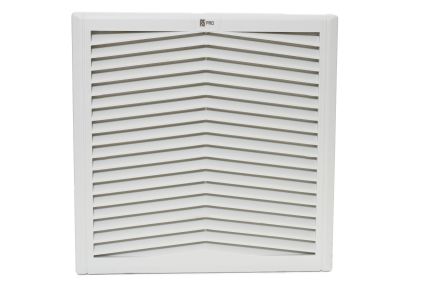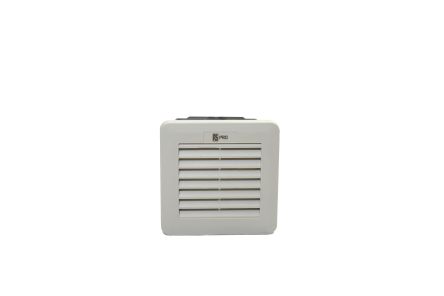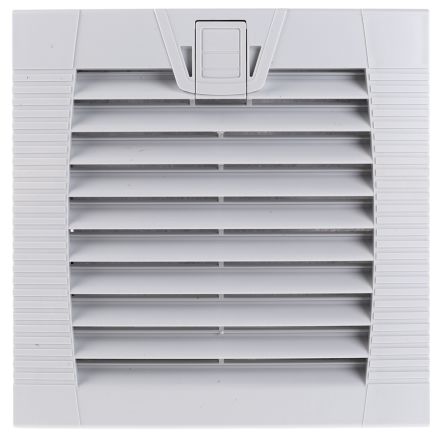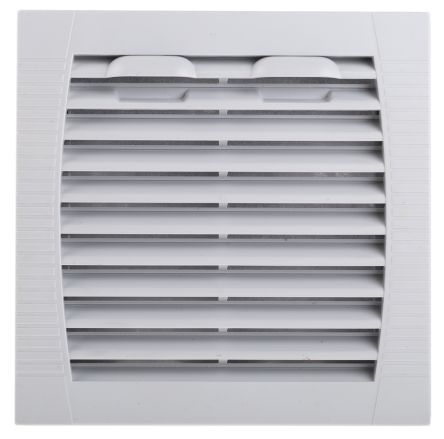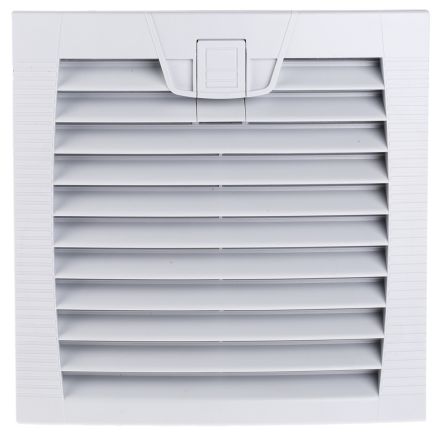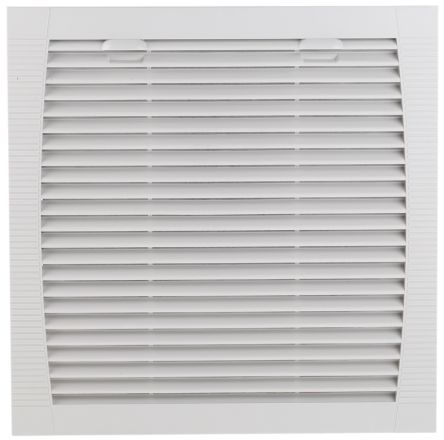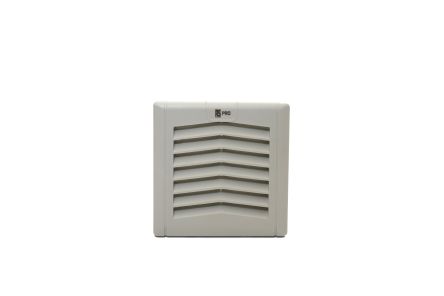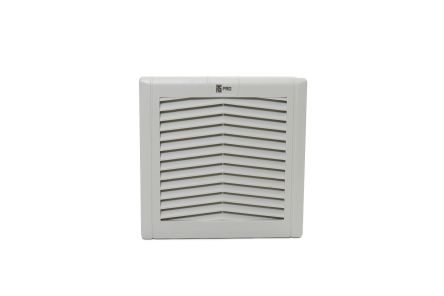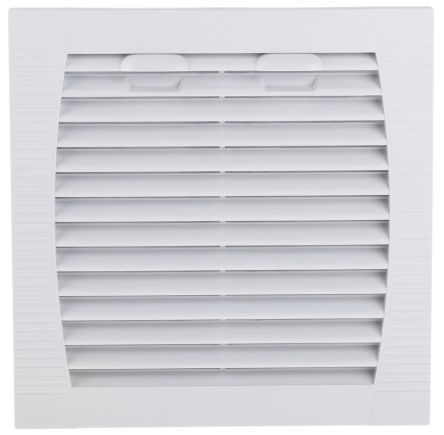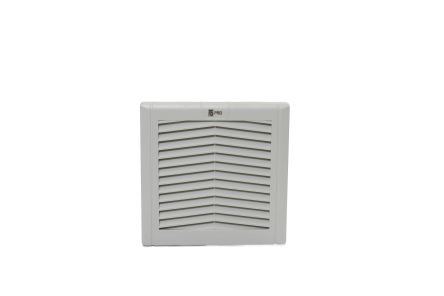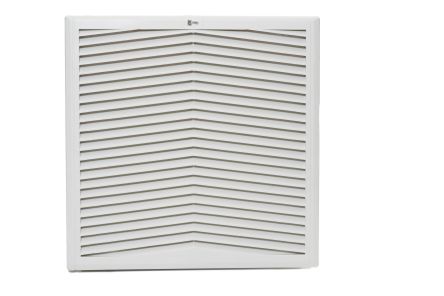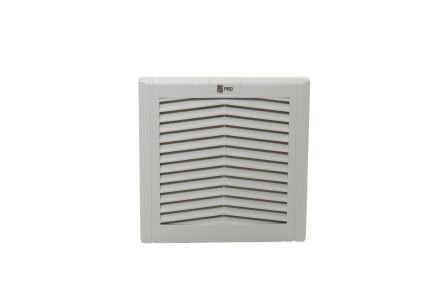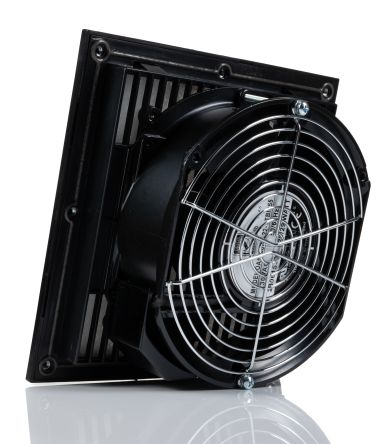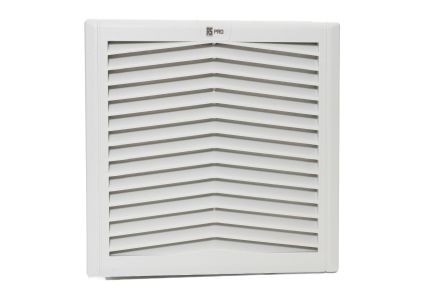- Automation & Control Gear
- Cables & Wires
- Enclosures & Server Racks
- Fuses & Circuit Breakers
- HVAC, Fans & Thermal Management
- Lighting
- Relays & Signal Conditioning
- Switches
- Batteries & Chargers
- Connectors
- Displays & Optoelectronics
- ESD Control, Cleanroom & PCB Prototyping
- Passive Components
- Power Supplies & Transformers
- Raspberry Pi, Arduino, ROCK, STEM Education & Development Tools
- Semiconductors
Filter Fans
Filter fans are air conditioners designed to aerate equipment enclosures, keeping them cool and well-ventilated to protect sensitive electrical components and equipment. They achieve this by combining a fan to circulate air and a filter to capture dust and other airborne particles, preventing contamination and ensuring a clean operating environment.
How Does a Filter Fan Work?
Filter fans, also known as cabinet fan filters or enclosure fan filters, effectively combine the cooling power of a fan with the protective filtration of a filter to maintain a controlled environment within electrical enclosures. The fan actively circulates air throughout the enclosure, facilitating heat dissipation and preventing overheating of sensitive electrical components and equipment.
Simultaneously, the filter captures harmful airborne particles, such as dust and dirt, preventing them from accumulating inside the enclosure and potentially causing damage to the equipment. This dual-action mechanism ensures a clean, cool and well-ventilated environment for sensitive electronics, promoting optimal performance and longevity.
Why are Filter Fans Used?
Air fan filters are often used in retrofit installations within electrical cabinets and enclosures, where excessive heat may develop due to a high density of equipment. The use of filter fans is crucial for preventing overheating and for filtering out dust particles, protecting sensitive components and ensuring the reliable operation of electrical systems. In addition to preventing overheating, filter fans can also help prevent electrical fires by reducing the risk of fuses blowing due to excessive heat buildup.
How to Choose the Right Filter Fan Size?
Choosing the right filter fan size is crucial for ensuring effective cooling and filtration within your electrical enclosure. Here are some key factors to consider:
- Determine the Airflow Requirement: Calculate the required airflow in cubic feet per minute (CFM) based on the heat dissipation of the enclosed equipment and the desired temperature difference between the inside and outside of the enclosure.
- Consider the Space and Volume: The size of the enclosure and the volume of air it contains will influence the required airflow. Larger enclosures generally require higher CFM ratings for effective cooling.
- Identify the Type of Contaminants: The type of dust, dirt or other airborne contaminants present in the environment will determine the appropriate filter type and efficiency.
- Account for Filter Resistance: The filter’s resistance to airflow will affect the fan’s performance. Choose a fan with sufficient airflow capacity to overcome the filter resistance and maintain adequate cooling.
- Ensure Compatibility with Equipment: Ensure the filter fan is compatible with the voltage and power requirements of your electrical equipment.
- Consider the Fan's Efficiency: Choose an energy-efficient fan filter to minimise power consumption and operating costs.
- Check Manufacturer Recommendations: Refer to the manufacturer's recommendations for selecting the appropriate filter fan size based on your specific enclosure and application.
- Factor in Environmental Conditions: Consider the ambient temperature, humidity and other environmental factors that may affect the performance of the filter fan.
- Check for Noise Level: The noise level of the filter fan can be an important consideration, especially in noise-sensitive environments.
- Consult an Expert if Necessary: If you're unsure about the right filter fan size or have complex requirements, consult an expert in industrial filter fans or enclosure cooling for assistance.
Types of Filter Fans
Filter fans come in various types, each designed for specific applications and airflow requirements. Here are some common types:
- Exhaust Filter Fans: These fans are designed to remove hot air and contaminants from the enclosure, creating negative pressure inside. They are commonly used in applications where heat dissipation is the primary concern.
- Intake Filter Fans: These fans draw in fresh, filtered air from the surrounding environment, creating positive pressure inside the enclosure. They are often used to prevent the ingress of dust and contaminants.
- High-performance Filter Fans: These fans offer higher airflow rates and are suitable for enclosures with high heat loads or demanding cooling requirements.
- Centrifugal Filter Fans: Centrifugal filter fans utilise a centrifugal impeller to move air, offering high static pressure capabilities and making them suitable for applications with restricted airflow or ductwork.
- Axial Filter Fans: Axial filter fans use an axial impeller to move air in a straight line, offering good airflow and efficiency for general-purpose ventilation and cooling.
- Compact Filter Fans: These fans are designed for enclosures with limited space, offering compact dimensions and efficient cooling for smaller applications.
- Heat Exchange Filter Fans: These fans utilise a heat exchanger to transfer heat from the enclosure to the outside environment, offering efficient cooling without the need for additional ventilation.
- Overpressure Filter Fans: These fans create positive pressure inside the enclosure, preventing the ingress of dust and contaminants even in harsh environments.
- Washable Filter Fans: These fans feature washable filters, reducing maintenance costs and minimising environmental impact.
Filter Fan Maintenance Tips
Proper maintenance of your filter fans is essential to ensure their optimal performance. Here are some tips to keep in mind:
- Regularly Clean the Filters: Dust and debris can accumulate on the filter media, reducing airflow and hindering the fan's cooling efficiency. Regularly clean or replace the filters according to the manufacturer's recommendations.
- Inspect the Fan Blades: Check the fan blades for any signs of damage, such as cracks, bends or excessive dust buildup. Damaged blades can reduce airflow and create noise. Clean the blades with a soft brush or compressed air to remove dust and debris.
- Lubricate Moving Parts: Lubricate the fan motor bearings and other moving parts periodically to ensure smooth operation and reduce wear and tear. Use a lubricant specifically designed for electrical equipment, and follow the manufacturer's instructions for lubrication frequency and procedures.
- Check for Airflow Obstructions: Ensure there are no obstructions to airflow around the filter fan, such as cables, components or other objects blocking the intake or exhaust vents. Obstructed airflow can reduce cooling efficiency and lead to overheating.
- Monitor for Unusual Noises: Unusual noises, such as grinding, rattling or excessive humming, can indicate a problem with the fan filter. Investigate the source of the noise and address any issues promptly to prevent further damage or malfunction.
- Inspect the Seals and Gaskets: Check the seals and gaskets around the filter fan for any signs of wear or damage. Damaged seals can allow dust and contaminants to enter the enclosure, compromising the equipment's protection.
- Check the Electrical Components: Periodically inspect the electrical connections and wiring of the filter fan for any signs of damage or loose connections. Ensure all electrical components are in good working order and properly connected.
- Replace the Filter When Necessary: Replace the filter media when it becomes clogged or damaged. The frequency of filter replacement will depend on the environment and the type of filter used.
Industrial Applications of Filter Fans
Filter fans are essential components in various industrial settings, including:
- Electronic Enclosures: Filter fans are widely used in electronic enclosures, such as control panels, server racks and telecommunications cabinets, to prevent overheating and protect sensitive electronic components from dust and contaminants.
- Machine Cooling: Many industrial machines, such as CNC machines, welding equipment and printing presses, generate significant heat during operation. Filter fans help dissipate this heat, preventing damage to the machine and ensuring optimal performance.
- Dust and Fume Extraction: In industries where dust, fumes or other airborne contaminants are present, filter fans can be used to extract these pollutants from the air, maintaining a clean and safe working environment.
- HVAC Systems: Filter fans are often integrated into HVAC systems to provide additional filtration and ventilation, improving air quality and ensuring efficient climate control in buildings and facilities.
- Automotive Manufacturing: The automotive industry utilises filter fans in various applications, such as paint booths and assembly lines, to maintain a clean and controlled environment, preventing contamination of vehicle components and ensuring high-quality finishes.
- Clean Rooms: Filter fans are crucial for maintaining the cleanliness and air quality in clean rooms, where even small amounts of dust or contaminants can compromise sensitive processes or products.
- Food and Beverage Industry: Filter fans are used in the food and beverage industry to maintain hygiene standards and prevent contamination in production areas, packaging lines and storage facilities.
- Pharmaceutical Manufacturing: The pharmaceutical industry relies on filter fans to maintain a sterile and controlled environment during the production of medications and other sensitive products.
- Warehouse Ventilation: Filter fans provide essential ventilation in warehouses, removing excess heat, moisture and airborne contaminants to ensure a comfortable and safe working environment for personnel and to protect stored goods.
Trusted Filter Fans Manufacturer, Supplier & Distributor in Australia
RS is a reliable provider of filter fans in Australia. We carry a wide range of electrical and industrial filter fans for your cabinets, enclosures and more. Shop filter fans from leading brands like Rittal, STEGO, Schneider Electric, and many more.
Buy Filter Fans Online from RS
Shop filter fans at RS Australia with fast and reliable nationwide shipping. Visit our Delivery Information page to learn more about shipping options and timelines.
Popular Searches
Related links
- Cooling Units
- Rittal SK Series Filter Fan ac Operation 180m³/h Unimpeded 255 x 255mm
- Floor Standing Enclosures
- Axial Fans
- Pfannenberg PF 22.000 Series Filter Fan AC Operation 178.5m³/h...
- STEGO Filter Fan Plus FPI Series Filter Fan AC Operation 19m³/h...
- STEGO Filter Fan Plus FPI Series Filter Fan AC Operation 305m³/h...
- STEGO Filter Fan Plus FPI Series Filter Fan AC Operation 170m³/h...

